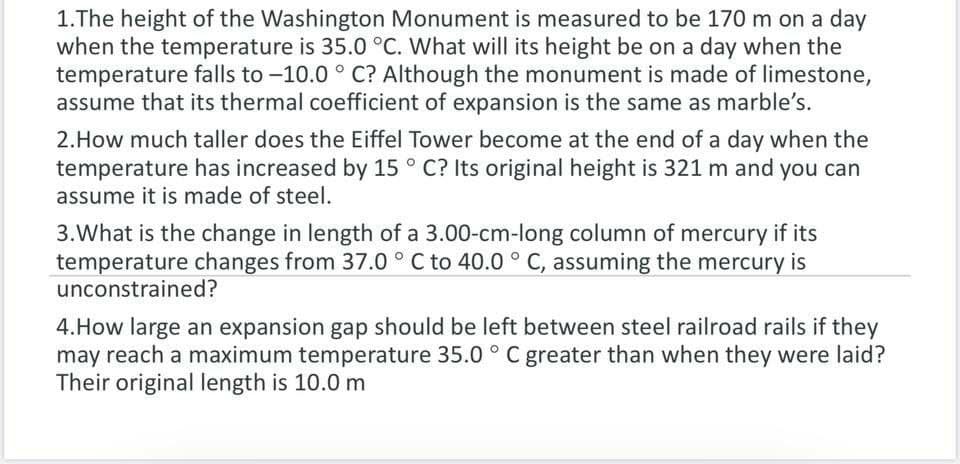1.The height of the Washington Monument is measured to be 170 m on a day when the temperature is 35.0 °C. What will its height be on a day when the temperature falls to -10.0 ° C? Although the monument is made of limestone, assume that its thermal coefficient of expansion is the same as marble's.
1.The height of the Washington Monument is measured to be 170 m on a day when the temperature is 35.0 °C. What will its height be on a day when the temperature falls to -10.0 ° C? Although the monument is made of limestone, assume that its thermal coefficient of expansion is the same as marble's.
Principles of Heat Transfer (Activate Learning with these NEW titles from Engineering!)
8th Edition
ISBN:9781305387102
Author:Kreith, Frank; Manglik, Raj M.
Publisher:Kreith, Frank; Manglik, Raj M.
Chapter8: Natural Convection
Section: Chapter Questions
Problem 8.9P
Related questions
Question

Transcribed Image Text:1.The height of the Washington Monument is measured to be 170 m on a day
when the temperature is 35.0 °C. What will its height be on a day when the
temperature falls to -10.0 ° C? Although the monument is made of limestone,
assume that its thermal coefficient of expansion is the same as marble's.
2.How much taller does the Eiffel Tower become at the end of a day when the
temperature has increased by 15 ° C? Its original height is 321 m and you can
assume it is made of steel.
3.What is the change in length of a 3.00-cm-long column of mercury if its
temperature changes from 37.0 ° C to 40.0 ° C, assuming the mercury is
unconstrained?
4.How large an expansion gap should be left between steel railroad rails if they
may reach a maximum temperature 35.0 ° C greater than when they were laid?
Their original length is 10.0 m
Expert Solution
This question has been solved!
Explore an expertly crafted, step-by-step solution for a thorough understanding of key concepts.
Step by step
Solved in 2 steps with 2 images

Knowledge Booster
Learn more about
Need a deep-dive on the concept behind this application? Look no further. Learn more about this topic, mechanical-engineering and related others by exploring similar questions and additional content below.Recommended textbooks for you

Principles of Heat Transfer (Activate Learning wi…
Mechanical Engineering
ISBN:
9781305387102
Author:
Kreith, Frank; Manglik, Raj M.
Publisher:
Cengage Learning

Principles of Heat Transfer (Activate Learning wi…
Mechanical Engineering
ISBN:
9781305387102
Author:
Kreith, Frank; Manglik, Raj M.
Publisher:
Cengage Learning